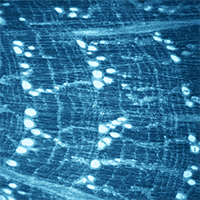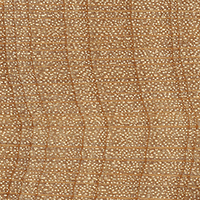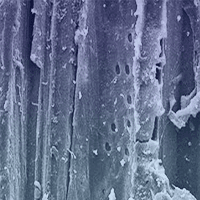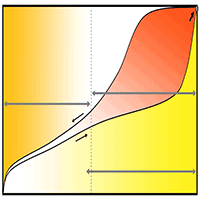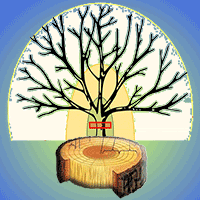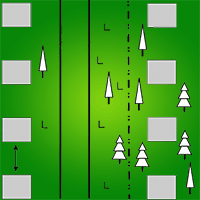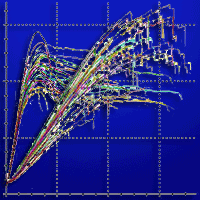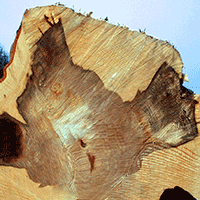
Can bark stripping cause red heartwood formation in beech stems?
Vladimír Račko (1) , Olga Mišíková (1), Pavol Hlaváč (2), Veronika Deáková (3)
iForest - Biogeosciences and Forestry, Volume 11, Issue 2, Pages 251-258 (2018)
doi: https://doi.org/10.3832/ifor2147-011
Published: Mar 12, 2018 - Copyright © 2018 SISEF
Research Articles
Abstract
Injuries to standing trees caused by logging and the subsequent changes in biochemical composition and anatomy of affected tissues lead to wood quality loss, thus lowering the commercial value of roundwood. In this study, we investigated the influence of various factors that could help mitigate or prevent the spread of infections in the stem caused by injuries. A total of 112 beech logs (tree age: 42-143 years) from ten forest stands at three different sites in central Slovakia were examined, and the extent of discolouration and decay zones in each stem was measured, along with cambial age, stem diameter, injury width, and injury closure period. The results showed that the width of physiologically active wet sapwood and the width of the inactive dehydrated zone in the stem are important factors influencing red heartwood formation. We found no significant differences in the extent of discolouration and decay among different stands and sites. Stem diameter and injury width did significantly affect the penetration of infection through sapwood, and red heartwood formation was significantly affected by cambial age and injury width, while stand age, site slope, beech proportion in the stand and injury closure did not show any significant effect. Binary logistic models were applied to assess the probability of pathogen penetration through sapwood into the stem dehydrated zone as a function of injury width and stem diameter, as well as the probability that this could lead to red heartwood formation based on injury width and cambial age of beech stems.
Keywords
Sapwood Width, Dehydrated Zone Width, Discoloration Depth, Decay Depth, Red Heartwood Formation
Authors’ Info
Authors’ address
Olga Mišíková
Department of Wood Science, Technical University in Zvolen, T.G.Masaryka 24, 960 53 Zvolen (Slovakia)
Department of Integrated Forest Protection and Landscape, Technical University in Zvolen, T.G.Masaryka 24, 960 53 Zvolen (Slovakia)
Institute of Foreign Languages, Technical University in Zvolen, T.G.Masaryka 24, 960 53 Zvolen (Slovakia)
Corresponding author
Paper Info
Citation
Račko V, Mišíková O, Hlaváč P, Deáková V (2018). Can bark stripping cause red heartwood formation in beech stems?. iForest 11: 251-258. - doi: 10.3832/ifor2147-011
Academic Editor
Giacomo Goli
Paper history
Received: Jun 21, 2016
Accepted: Dec 27, 2017
First online: Mar 12, 2018
Publication Date: Apr 30, 2018
Publication Time: 2.50 months
Copyright Information
© SISEF - The Italian Society of Silviculture and Forest Ecology 2018
Open Access
This article is distributed under the terms of the Creative Commons Attribution-Non Commercial 4.0 International (https://creativecommons.org/licenses/by-nc/4.0/), which permits unrestricted use, distribution, and reproduction in any medium, provided you give appropriate credit to the original author(s) and the source, provide a link to the Creative Commons license, and indicate if changes were made.
Web Metrics
Breakdown by View Type
Article Usage
Total Article Views: 47731
(from publication date up to now)
Breakdown by View Type
HTML Page Views: 40936
Abstract Page Views: 2534
PDF Downloads: 3097
Citation/Reference Downloads: 21
XML Downloads: 1143
Web Metrics
Days since publication: 2833
Overall contacts: 47731
Avg. contacts per week: 117.94
Citation Metrics
Article Citations
Article citations are based on data periodically collected from the Clarivate Web of Science web site
(last update: Mar 2025)
Total number of cites (since 2018): 2
Average cites per year: 0.25
Publication Metrics
by Dimensions ©
Articles citing this article
List of the papers citing this article based on CrossRef Cited-by.
References
Albert L, Hofmann T, Németh Z, Rétfalvi T, Koloszár J, Varga, S, Csepregi, I (2003) Radial variation of total phenol content in beech (Fagus sylvatica L.) wood with and without red heartwood. European Journal of Wood and Wood Products 61: 227-230.
CrossRef | Gscholar
Buchenrotkern: Erkennung, verbreitung und wirtschaftliche bedeutung. [Red heartwood formation in beech: identification, occurrence and economic importance]. Schweizerische Zeitschrift fur Forstwesen 149 955-970. [in German]
Gscholar
Gutes Überwallungsvermögen der Rotbuche bei Schälschäden im Dickungsstadium [Good occlusion capability in beech after bark-stripping damage in the thicket stage]. Allgemeine Forstzeitschrift: 452-454. [in German]
Gscholar
Einfluß der Verletzungszeit auf die Wundreaktionen verschiedener Laubbäume und der Fichte [Influence of time of wounding on the wound reactions of various broadleaves and Norway spruce]. Forstwissenschaftliches Centralblatt 110:371-380. [in German]
CrossRef | Gscholar
Do site factors affect the wood quality of European beech (Fagus sylvatica L.)? Results from a pre-study on red heartwood. Forst und Holz 61: 464-468.
Gscholar
Atlas lesnícky významných húb rastúcich v porastoch VšLP TU vo Zvolene [Atlas of forestry important fungi growing in forests of Forest Enterprise the Technical University Zvolen]. Technical university press, Zvolen, Slovakia, pp. 159. [in Slovak]
Gscholar
Applied logistic regression. John Wiley and Sons, Inc., New York City, USA, pp. 383.
Gscholar
Vznik thyl v bukovém dreve. [Tylosis formation in beech wood]. Wood Research 1: 7-15. [in Slovak]
Gscholar
Wachstum großkroniger Buchen und waldbauliche Konsequenzen. [Growth of beeches with large crowns and consequences for silviculture]. Forstarchiv 73: 211-217. [in German]
Gscholar
Ein Ansatz zur Beschreibung von Wahrscheinlichkeit und Ausmass der Farbkernbidung bei Buche (Fagus sylvatica L.). [An approach to predict probability and extent of red coloured heartwood in beech (Fagus sylvatica L.)]. Forstwissenschaftliches Centralblatt 120: 154-172. [in German]
CrossRef | Gscholar
Untersuchungen über den kern der rotbuche [Studies of red heartwood in beech]. Allgemeine Forst Zeitung 73: 186-191. [in German]
Gscholar
Die buche und ihr holz - eine einfuhrung in die problematik [The beech and its wood - an introduction to the problem]. Schweizerische Zeitschrift für Forstwesen 142: 363-373. [in German]
Gscholar
Jadro buku: struktura, vznik a vyvoj [Beech heartwood: structure and formation]- Slovak Academy of Sciences, Bratislava, Slovakia, pp. 231. [in Slovak]
Gscholar
Zrelé drevo ako limitujúci faktor vzniku nepravého jadra buka (Fagus sylvatica L.) [The ripewood as a limiting factor of the false heartwood formation of beech (Fagus sylvatica L.)]. Acta Facultatis Xylologiae 52: 15-24. [in Slovak]
Gscholar
TANAGRA: a free software for research and academic purposes. In: Proceedings of the Meeting “EGC 2005” (RNTI-E-3 ed). Amsterdam, Netherlands, pp. 697-702.
Gscholar
Kerntypen der rotbuche [Type of beech heartwoods]. Forstarchiv 62: 238-241. [in German]
Gscholar
Untersuchung über mögliche Zusammenhänge zwischen mechanischen Stammverletzungen und Kernbildung bei Fagus sylvatica [Investigation on eventual relations between artificial stem wounds and heartwood formation in Fagus sylvatica]. Forstarchiv 52: 179-183. [in German]
Gscholar
Wunden und wundfäulen bei der Buche. [Wounds and wound rot in beech]. Allgemeine Forstzeitschrift 48: 456-460. [in German]
Gscholar

